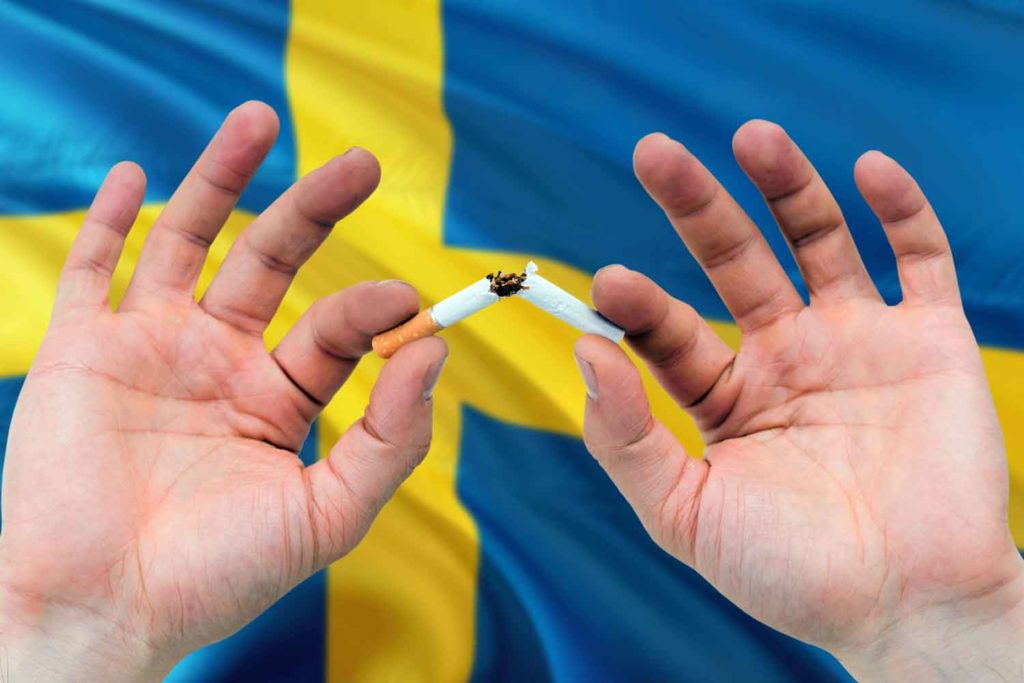News
Sweden Close To Becoming First ‘Smoke Free’ Country In Europe For 2024

STOCKHOLM — In Sweden’s outdoor bars and eateries, summer is in the air but not cigarette smoke.
The World Health Organisation will observe “World No Tobacco Day” on Wednesday, and Sweden, which has the lowest smoking rates in the European Union, is almost ready to declare itself “smoke free” (defined as having fewer than 5% of the population smoking every day).
While others refer to the presence of “snus,” a smokeless tobacco product prohibited elsewhere in the E.U. but marketed as an alternative to cigarettes in Sweden, many experts credit decades of anti-smoking campaigns and laws.
Regardless of the cause, the 5% goal is now within sight. According to the statistics agency Eurostat, only 6.4% of Swedes over 15 smoked every day in 2019, the lowest rate in the E.U. and significantly lower than the average of 18.5% for the 27-nation bloc.
According to statistics from Sweden’s Public Health Agency, the smoking rate has decreased since then and last year, it was 5.6%.
Carina Astorsson, a Stockholm resident, claimed that the reason was that “we like a healthy way of living.” She said she had never been interested in smoking because “I don’t like the smell; I want to take care of my body.”
Younger generations of health-conscious Swedes appear to be aware of the dangers of smoking. Nearly 20% of people smoked 20 years ago, a low rate globally. Since then, anti-smoking policies, such as those that forbid smoking in restaurants, have reduced the smoking rate throughout Europe.
From 2014 to 2019, France saw record-low smoking rates, but this progress halted during the COVID-19 epidemic, which is partly blamed for creating the stress that led to smoking. In France, about one-third of those between 18 and 75 admitted smoking in 2021, a small rise from the previous year. 25% of people smoke every day.
Sweden, which has the lowest smoking rates in the European Union, is almost ready to declare itself “smoke free”.
Sweden has taken more steps than others to outlaw smoking, and the country claims that this has positively impacted several health factors, including a comparatively low rate of lung cancer.
According to Ulrika Rehed, secretary-general of the Swedish Cancer Society, “We were early in restricting smoking in public spaces, first in school playgrounds and after-school centers, and later in restaurants, outdoor cafes, and public places like bus stations.” Taxes on cigarettes and severe regulations on marketing these items have been significant concurrent factors.
She continued, “Sweden is not there yet,” pointing out that smoking prevalence is higher among underprivileged socioeconomic categories.
In the 10.5 million-person nation, seeing individuals lighting up is getting harder and harder. Outside the entrances to hospitals and other public facilities, as well as at bus stops train platforms, and smoking is not permitted. Like most of Europe, Sweden has a smoking prohibition extending to bars and restaurants’ outdoor seating areas as of 2019.
On Tuesday night, many people ate and drank on Stockholm’s terraces as the sun sank. While cigarettes were not present, some tables did have snus cans. Some drinkers put tiny pouches of moist tobacco under their upper lips between beer sips.
Long promoting their product as a less dangerous alternative to smoking, Swedish snus manufacturers take pride in the nation’s dropping smoking rates. Health officials in Sweden hesitate to suggest smokers switch to snus, another extremely addictive nicotine substance.
Rehed declared, “I don’t see any justification for pitting two harmful products against one another.” “It is true that smoking is more dangerous than most other activities, including snus. But even with snus, there are numerous health hazards.
Snus use during pregnancy has been associated in certain studies with an increased risk of heart disease, diabetes, and preterm births.
Sweden, which has the lowest smoking rates in the European Union, is almost ready to declare itself “smoke free”.
When Sweden joined the E.U. in 1995, they wanted an exception to the E.U.’s ban on smokeless tobacco since they are so fond of their snus, a distant relative of dipping tobacco in the United States.
“It’s part of the Swedish culture; it’s like the Swedish equivalent of Italian Parma ham or any other cultural habit,” said Patrik Hildingsson, a spokesman for Swedish Match, the leading snus producer in Sweden that tobacco giant Philip Morris recently purchased.
According to him, policymakers should push the tobacco industry to create less dangerous smoking substitutes like snus and e-cigarettes.
“I mean, there are still 1.2 billion smokers in the globe. In the E.U., almost 100 million individuals smoke every day. And I believe that the restrictions on policymaking are limited,” he remarked. You will need to offer smokers various alternate, less dangerous options.
Turkmenistan, which has a tobacco consumption rate below 5%, is ahead of Sweden in terms of phasing out smoking, according to WHO, the U.N. health office. However, it should be noted that this is mostly because smoking is virtually nonexistent among women. The rate is 7% for men.
The WHO credits a variety of tobacco control initiatives, such as education programs, restrictions on tobacco advertising, and “cessation support” for smokers who want to give up the habit, for Sweden’s dropping smoking rate. However, the agency pointed out that when you include snus and similar products, tobacco usage in Sweden is higher than 20% of the adult population, comparable to the global average.
Sweden, which has the lowest smoking rates in the European Union, is almost ready to declare itself “smoke free”.
In an email, which stated that “changing from one harmful product to another is not a solution.” The tobacco industry is attempting to deceive consumers about how deadly these products are by promoting a purported “harm reduction approach” to smoking.
According to Tove Marina Sohlberg, a researcher at the Department of Public Health Sciences at Stockholm University, Sweden’s anti-smoking laws stigmatize smoking and smokers, driving them into designated smoking locations and out of sight in public places.
She claimed that we are telling smokers their behavior is unacceptable in society.
One of the few remaining smokers in Stockholm, Paul Monja, thought about his habit as he prepared to light up.
He described it as an addiction that he hoped to overcome at some point. “Perhaps not now, maybe tomorrow.”
SOURCE – (AP)
News
Britain Must Be Ready for War in 3 Years, Warns New Army Chief

The new head of the Army has stated that Britain must be prepared to fight a war within three years.
Gen Sir Roland Walker has issued a warning about a variety of risks in what he calls a “increasingly volatile” environment.
However, he stated that war was not inevitable and that the Army had “just enough time” to prepare to prevent conflict.
He stated that the Army’s fighting capacity would be doubled by 2027 and tripled by the end of the decade.
Gen Walker warned that the Britain was under threat from a “axis of upheaval” in his first speech as Prime Minister on Tuesday.
Among the primary concerns confronting the Britain in the next years, as noted by the general in a briefing, is an enraged Russia, which may seek vengeance on the West for helping Ukraine, regardless of who wins the war.
He stated: “It doesn’t matter how it finishes. I believe Russia will emerge from it weaker objectively – or completely – but still very, very dangerous and seeking some form of retaliation for what we have done to assist Ukraine.”
Britain’s Government Defence Review and Military Challenges
He also warned that China was determined to retake Taiwan, and Iran was likely to seek nuclear weapons.
He stated that the threats they posed may become particularly acute in the next three years, and that these countries had formed a “mutual transactional relationship” since the war in Ukraine, sharing weaponry and technology.
However, he stated that the path to conflict was not “inexorable” if the UK re-established credible land troops to assist its deterrent strategy for avoiding war.
In his speech, he described his force of slightly over 70,000 regular troops as a “medium-sized army” and made no direct call for additional resources or men.
However, he pushed the British Army to adapt swiftly, focussing on technology such as artificial intelligence and weaponry rather than numbers.
His ultimate goal is for the Army to be capable of destroying an opponent three times its size.
This would entail firing quicker and farther, he said, aided by lessons learnt from the Ukraine war.
The general’s speech at the Royal United Services Institute land warfare conference comes only one week after the government began a “root and branch” defence review to “take a fresh look” at the challenges facing the armed services.
Defence Secretary John Healey launched the assessment, describing the existing status of the armed forces as “hollowed-out” and stating that “procurement waste and neglected morale cannot continue”.
According to the most recent Ministry of Defence (MoD) numbers from April 2024, the Britain’s regular Army forces total 75,325 troops (excluding Gurkhas and volunteers).
That figure has been declining in recent years, as recruiting has failed to match retention. The previous Conservative administration lowered the planned headcount from 82,000 to 72,500 by 2025.
Members of the NATO military alliance have agreed to spend at least 2% of GDP on defence by 2024, but several countries are unlikely to fulfil this goal.
The Britain presently spends 2.3% of its GDP on defence. Prime Minister Sir Keir Starmer has previously stated that the defence review will include a “roadmap” for increasing this to 2.5%, however he has yet to provide a date for this promise.
Source: BBC
News
Katie Ledecky Hopes For Clean Races At Paris Olympics In The Aftermath Of The Chinese Doping Scandal

PARIS — Katie Ledecky is looking for clean Olympic races. On Wednesday, Hope had pretty much reached her limit.
The American swimmer hopes to add to her six gold medals as she competes in the 400, 800, and 1,500 meters at the Paris Games. Her program starts with the heavy 400 on Saturday, featuring Ariarne Titmus and Summer McIntosh.

Katie Ledecky | ESPN Image
Katie Ledecky Hopes For Clean Races At Paris Olympics In The Aftermath Of The Chinese Doping Scandal
The 27-year-old Katie is competing in her fourth Summer Olympics, but the first since a doping scandal involving almost two dozen Chinese swimmers who tested positive for a banned chemical before the Tokyo Games — yet were permitted to compete with no consequences. The controversy has raised serious worries regarding the effectiveness of anti-doping initiatives.

Katie Ledecky | Vogue Image
“I hope everyone here is going to be competing clean this week,” Ledecky claimed. “But what truly counts is, were they training cleanly? Hopefully this has been the case. Hopefully, there has been worldwide testing.”
The International Olympic Committee has expressed concern over the ongoing US investigation into possible doping by Chinese swimmers. While awarding the 2034 Winter Olympics to Salt Lake City on Wednesday, the IOC urged Utah officials to do whatever they could to stop the FBI investigation.
“I think everyone’s heard what the athletes think,” Katie added. “They seek transparency. They want more answers to the remaining questions. At this point, we are here to race. We are going to race whoever is in the lane next to us.
“We are not paid to conduct the tests, so we trust those who follow their regulations. That applies both today and in the future.

Katie Ledecky | ESPN Image
Katie Ledecky Hopes For Clean Races At Paris Olympics In The Aftermath Of The Chinese Doping Scandal
SOURCE | AP
News
London Heatwave Alert: High Temperatures Set to Soar to 29C Next Week

As the summer holidays begin, London may experience an official heatwave with temperatures reaching up to 29 degrees Celsius.
The Met Office predicts a long period of sunny and dry weather for London after a soggy spring and summer.
After a cloudy day on Saturday, temperatures are expected to reach 27C on Sunday, with lots of sunlight.
On Monday and Tuesday, temperatures are forecast to peak at 29 degrees Celsius. Monday is forecast to offer more sunlight, while Tuesday may see some gloomy weather.
Temperatures are expected to remain in the high 20s next week, with lows of approximately 18C.
According to the Met Office, a heatwave is “an extended period of hot weather relative to the expected conditions of the area at that time of year, which may be accompanied by high humidity.”
In the United Kingdom, a heatwave is proclaimed when daily temperatures meet or surpass a certain level for at least three consecutive days.
In London, the heatwave threshold is 28 degrees Celsius.
The Met Office reported that the UK is experiencing hotter and wetter weather on average due to climate change.
The UK experienced its warmest May and April on record this year, despite damp and dismal conditions in many areas.
According to the Met Office’s State Of The UK Climate 2023 report published on Thursday, the UK experienced historic levels of extreme weather last year.
In the United Kingdom, 2023 was the second warmest year on record, bringing storms, flooding, strong heatwaves, and rising sea levels; only 2022 was warmer.
It was 0.8°C higher than the average from 1991 to 2020, and 1.66°C higher than the 1961 to 1990 average.
However, 2023 will be a “cool year” in comparison to 2100, based on the planet’s warming trajectory.
The government’s plan to adapt to the hazards presented by climate change is currently being challenged in the High Court by campaigners who allege the Tory administration’s July 2023 National Adaptation Programme (NAP) fails to adequately address 61 concerns.
Source: The Standard
-
World2 weeks ago
Former President Trump Survives Being Shot at Pennsylvania Rally
-
Tech4 weeks ago
Huawei Launches 5G-A Pioneers Program at MWC Shanghai 2024: Paving the Way for a Connected Future
-
Sports4 weeks ago
NBA Draft: Kyle Filipowski Withdraws Unexpectedly From The First Round
-
Tech4 weeks ago
ChatGPT Answers Undiscovered Questions and Outperforms Students.
-
News4 weeks ago
US Supreme Court Rejects Drug Deal that Protects the Sackler Family
-
Health4 weeks ago
US Health Agency Issues Dengue Virus Infection Warning






















